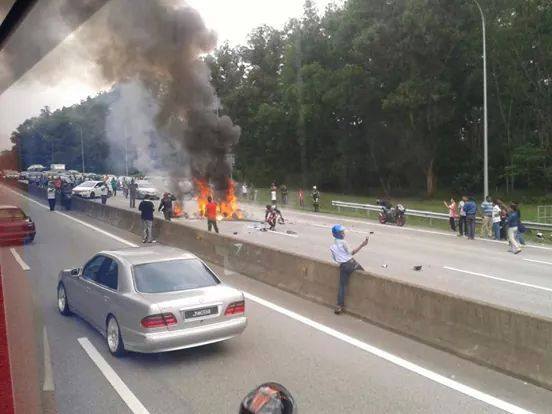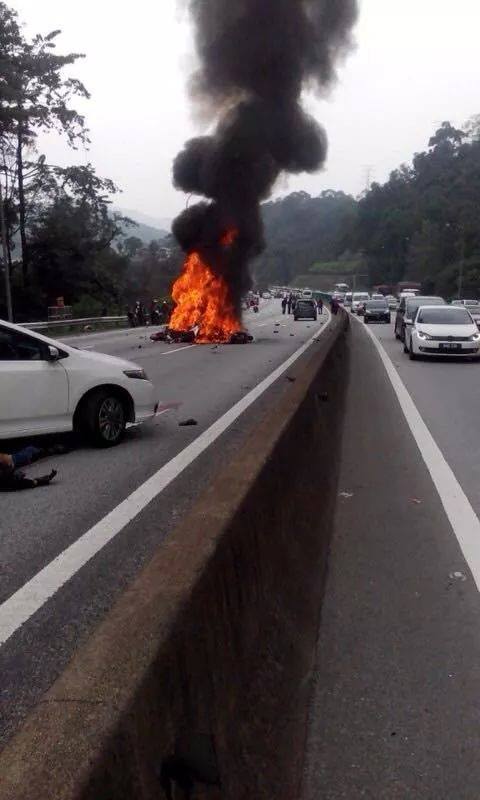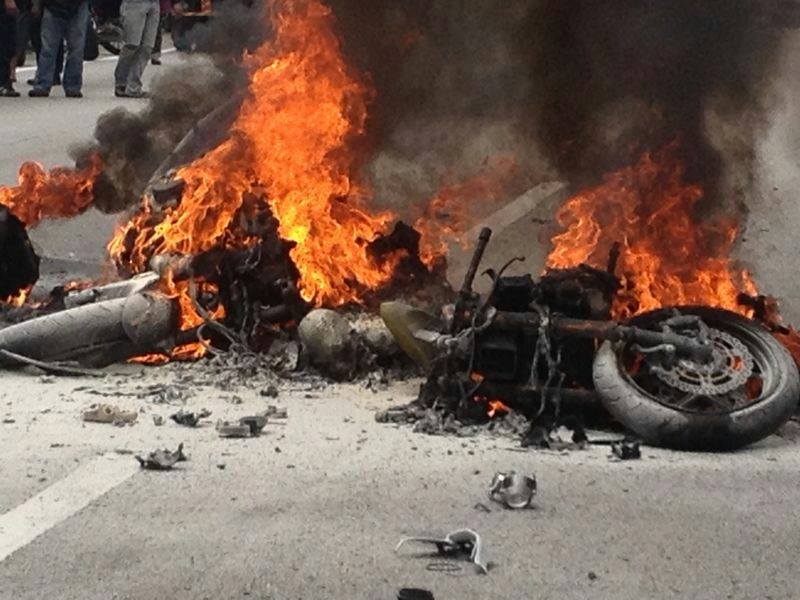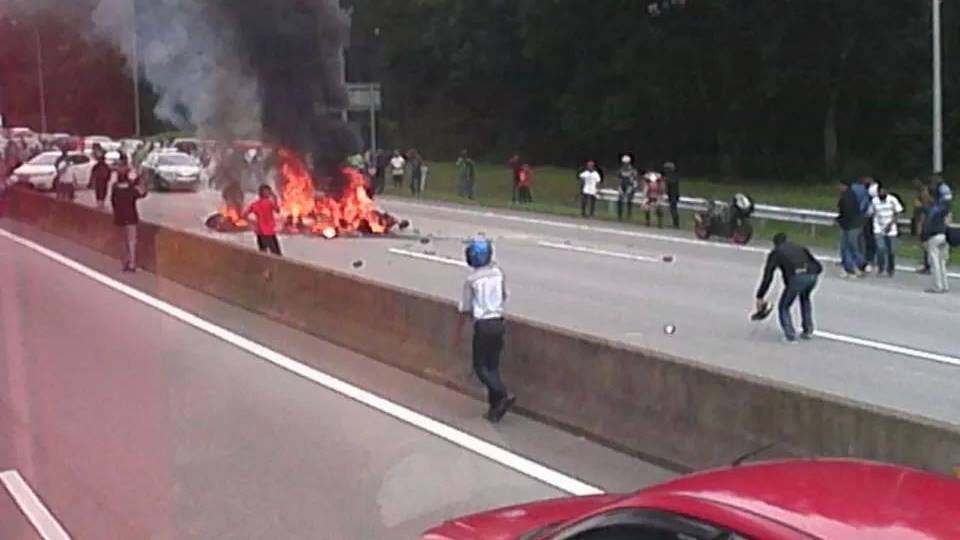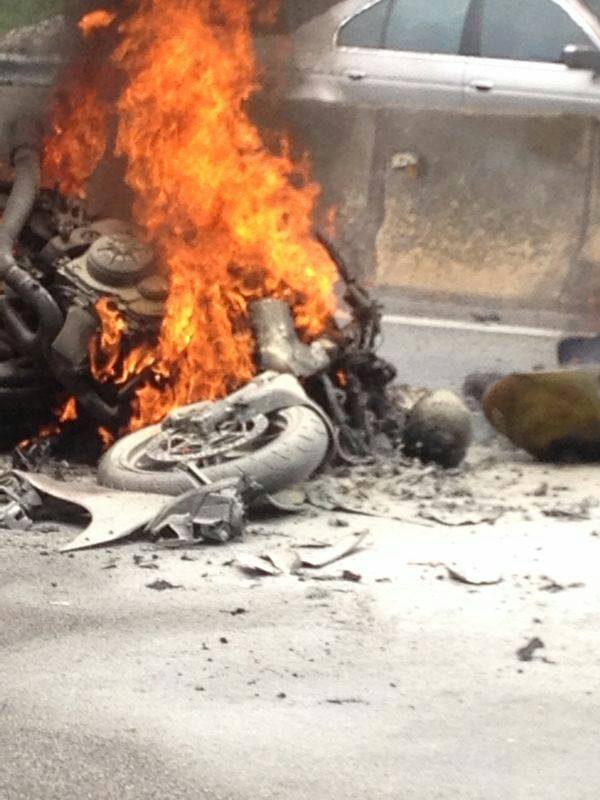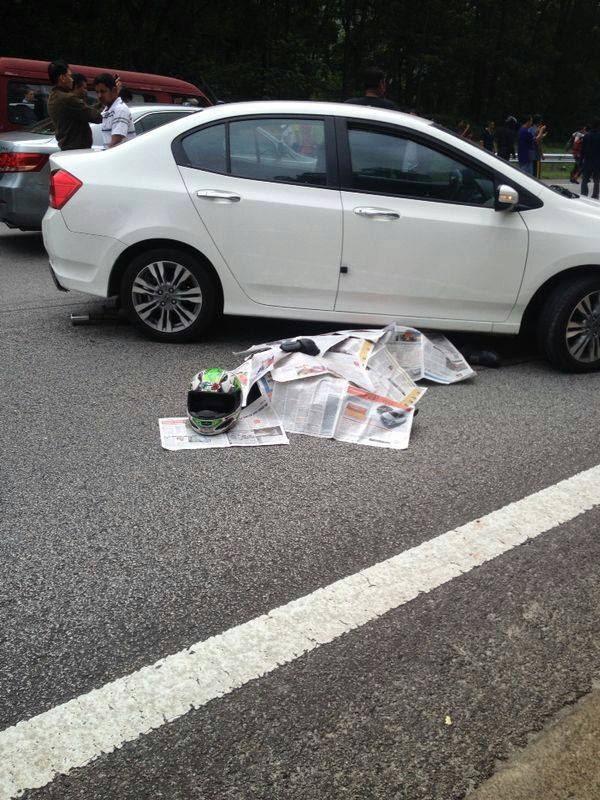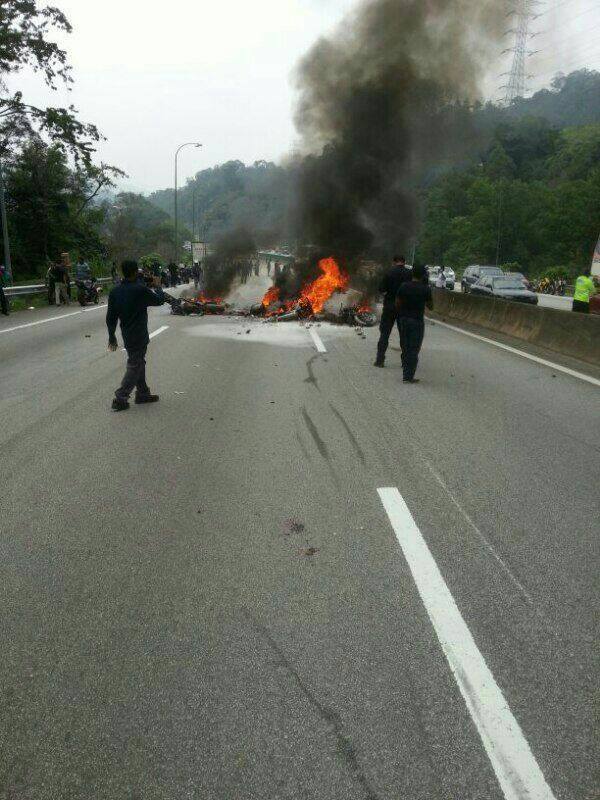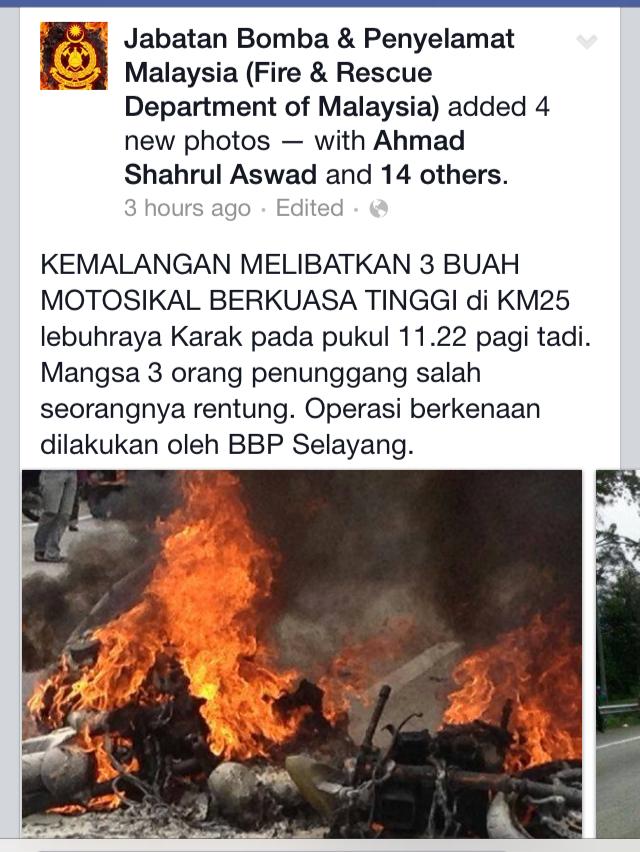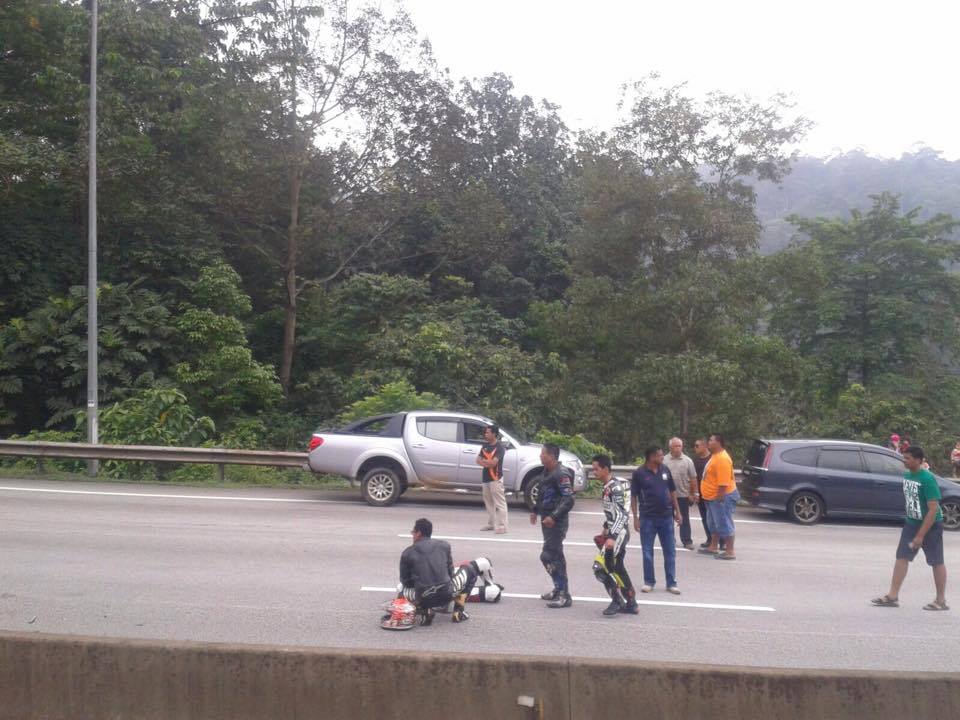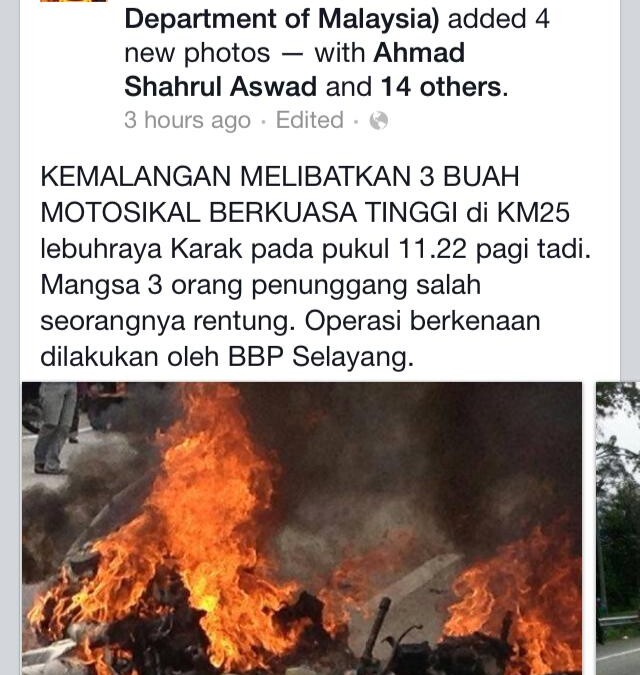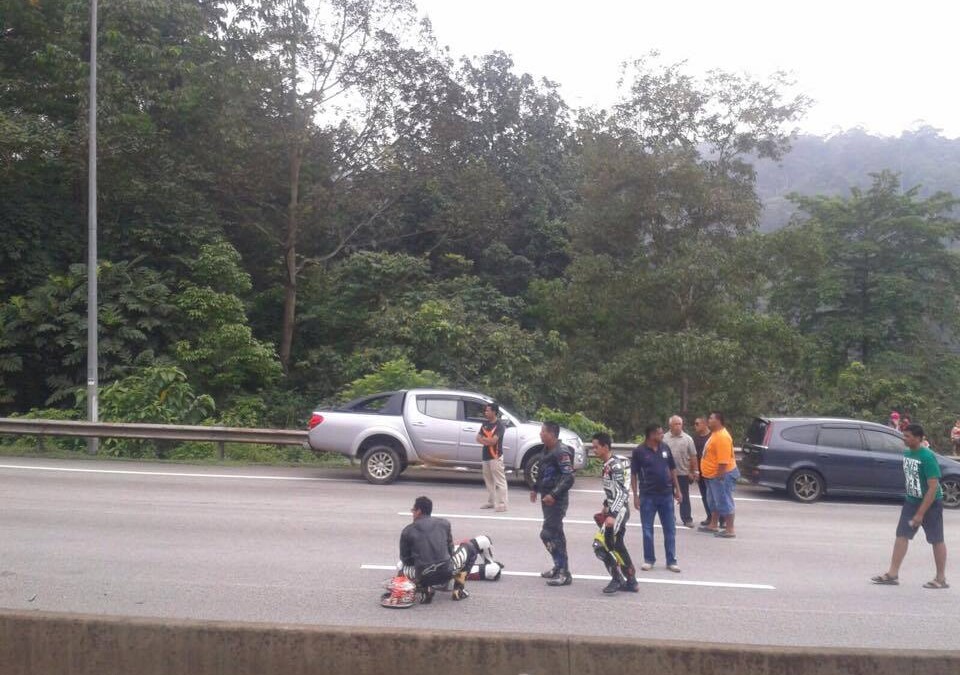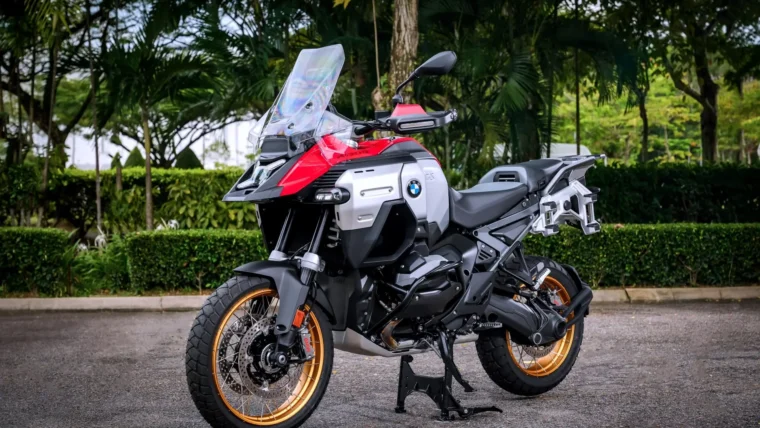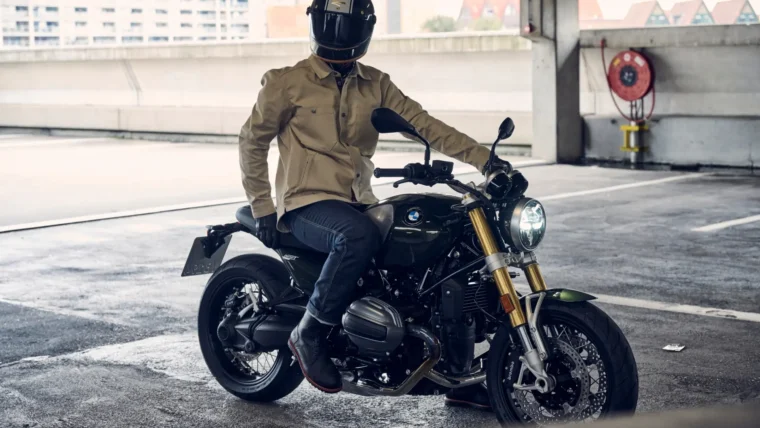It was another tragic weekend for motorists, bikers in particular, and in all my many years of biking, this has to be one of the worst accidents I’d ever seen or even heard of. By now you would have seen the photos on various social media, and in fact it’s even made the headline news on some local dailies.
Apparently on Sunday 19th October, at around 11am, a trailer-truck skidded and came to a halt diagonally along the Karak Highway leading back to KL, blocking all lanes. As the cars began to slow down and come to a halt, an approaching group of Superbikers traveling at high speed were unable to stop in time – I reckon this area is after a fast crest – and collided heavily with some of the cars, which resulted in a fire.
Details of the mortality rate were sketchy at first, but one thing was for sure, one of the bikers was burnt to death in the resulting conflagration. Images of a charred body on the road soon filled social media sites, and I’m quite sure I wasn’t the only one completely horrified and left very disturbed by this scene.
While the incident is still being investigated, let’s dissect what possibly happened. I did mention in passing to a fellow biker friend of mine that it looked like a scene from the movie ‘Final Destination’, because it was a chain-reaction of events, all happening at the exact same time and in proper sequence to cause this tragedy.
First-off, the Karak Highway. Driven at a leisurely pace, and taken for what it is, it’s a very nice, picturesque highway with long sweeping bends, crests, hills and beautiful scenery. It eventually leads to the new LPT or East Coast Link to get to Kuantan, Terengganu, etc. However, it also leads to three favourite ‘Sunday Ride’ destinations; Genting Highlands, Bentong and Berjaya Hills (a.k.a. Bukit Tinggi).
On any given Sunday, the Karak Highway will be filled with bikers heading for these destinations. Having driven and ridden on this highway countless times, I’ve noticed a few things that could easily create a deadly situation like the one that happened yesterday, very quickly. Huge trucks and buses often ply this highway, and while most will stick to the slowest lane on the left, if fully laden, they will slow to a snail’s pace when going up an incline.
This effectively turns the highway into a 2-laner, and then I have noticed the odd aforementioned lorry or bus try to overtake each other, while struggling up an incline themselves! So now, the highway becomes ONE lane, which forces all faster moving vehicles into the overtaking lane, right next to the centre barrier. A vehicle approaching at speed, may not realize that the speed on the overtaking lane has just decreased by 80%, and if this sudden ‘filter’ has happened around one of the many ‘blind’ corners or after a crest, there is little or no time to react at all. All the more reason to adhere to the speed limit.
Now let’s look at the vehicles involved. Latter day superbikes are incredibly powerful. It’s not surprising anymore for litre-class superbikes to be able to hit speeds in excess of 300kmh, yes, three-hundred. It takes a very skilled rider to be able to handle a bike at speeds like that, where even just falling-off means death. Seriously, you don’t need to hit anything, if you just fall off at 300kmh, you die. Our bodies simply cannot withstand the impact, as mentioned in my recent ‘crash-test’ article.
Now I’m not saying the bikers involved in this terrible tragedy were doing 300kmh, but according to eyewitnesses, they were indeed traveling at a very rapid pace, in close proximity to each other, commonly known as ‘slip-streaming’. You will see MotoGP racers do this all the time. Slip-streaming means the bike in front is the one punching through the air, which means the bike behind it isn’t suffering from wind-resistance. So technically, if both bikes are of equal power, the one behind can actually cut-out and over take, because the bike still has power in reserve from not having to punch through the air. It also means the biker behind is blind to what’s up ahead, while riding on the limit.
On a track though, if something goes wrong with this maneuver, well, it’s into the sand-trap or tyre/inflatable-wall, and more often than not, the downed racer walks back to the pits, a bit sandy, maybe slightly shaken and bruised, but otherwise alive. The chances of you surviving a similar incident on the Karak highway are extremely slim, because the sand-traps and inflatable-walls have been replaced with concrete barriers, metal Armcos and other vehicles.
“‘Let he who is without sin cast the first stone” thus I shall not, for I am guilty of this as well. I gave up big-bore litre-class superbikes in favour of much slower ‘retro-classics’ long ago because the tendency to simply go too fast was too great a temptation to resist. It really is intoxicating and the adrenalin rush is indescribable; it becomes like a drug actually. My last superbike was an old Kawasaki ZZR1100, and despite being almost two-decades old (that’s like 100 years in the superbike world) it was still able to hit speeds in access of 200kmh, easily. I distinctly recall seeing 260kmh on more than one occasion, till one day I had an epiphany. I asked myself why.
I had completely lost the plot when it came to the joys of biking. Biking, for many, is an expression of freedom. It’s just you and the bike, the road and the elements; even the destination is unimportant, and as I’ve said before ALL that is lost when you’re simply trying to go faster than the next guy. I have said this so many times that I’ve lost count; save the racing for the track. Sunday rides are not about racing, it’s a day off from work to enjoy a ride with friends, or alone, like I frequently do; just enjoy the ride. My fellow bikers, please, please slow down.
On behalf of Autofreaks, I extend our deepest condolences to the families, relatives and friends of those lost in this terrible tragedy. Let their sacrifice be a lesson to us all so that their deaths may not be in vain.
Image source: Jabatan Bomba & Penyelamat / FB
Other posts by Chris Wee


